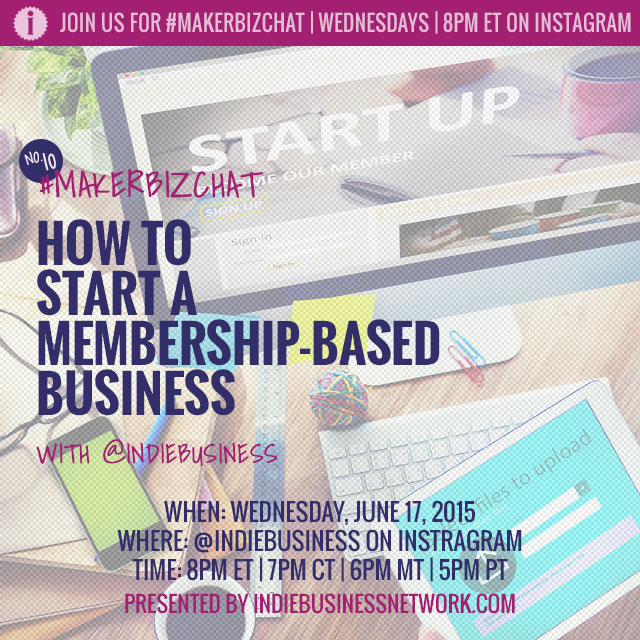On Wednesday evenings from 8 to 8:30pm ET, I host #MakerBizChat, an Instagram event to help Makers and Handmade Entrepreneurs build a solid business foundation, increase your income, and use your business to create the life you love. Our topic last night was How to Build a Membership-Based Business. While most people use the terms “membership site” and “membership business” interchangeably, they are really quite different. Just because you have a site on the Internet does not mean you have a business. I focus on helping people build businesses, and a website is a component of that.

I use the term “Membership Site” in the title of this post simply because that's what most people do and I want the important information in this post to be found by as many people as possible.
People frequently ask me how to start a membership-based business because they know I have led the Indie Business Network for nearly 16 years. IBN is the first membership-based business model on the Internet (as far as I know), so this is an area in which I have a great deal of experience, knowledge and expertise.
Even if you don't want to lead a membership-based business per se, you ‘ll get a lot of ideas here if you want to add a membership component to an existing business, or just enhance the community experience around the business you have.
You can read the full transcript on Instagram, including questions, tips and resources from the Maker community, at this link. Because Instagram is designed for mobile viewing, the entire chat on Instagram, which has dozens of comments and some great questions and discussion, is best viewed on a mobile device. Here is a summary of last night's #MakerBizChat.
Q1: WHY SHOULD I CONSIDER A MEMBERSHIP-BASED BUSINESS MODEL?
”
Donna Maria, Indie Business Network
A1(a) A membership-based business model is a great way to share your expertise and passion, and get paid for it.
A1(b) Membership models are popular for the same reason subscription boxes are — they offer an opportunity to build a steady stream of recurring income by charging users a fee (usually monthly or yearly) to access products and services they cannot get anywhere else.
A1(c) It's a great model for many Makers who want to supplement income from product sales.
A1(d) Technology has advanced to offer many options for hosting, etc., so it is not as hard or as pricey as it was when I started out.
Q2: WHAT IS THE FIRST THING I SHOULD DO TO GET STARTED?
A2(a) Decide what area of expertise you will build your business around. What will your niche be? You may have more than one option here, but start with one so you can maintain laser focus and hone in on a particular target audience.
A2(b) Experiment with blog posts, surveys and social media updates that ask prospective customers what they'd most like to learn or receive from you. Is it information and tips? Recipes and how to's?
A2(c) Call prospective members and ask them what they'd like to see you do. (Phone calls are personal and you'll get more information than from surveys.)
Q3: WHAT COMMON MISTAKES SHOULD I AVOID ON THE FRONT END?
A3(a) Do not spend money at first on monthly or annual membership site options, which can cost $50 a month or more, not including technical support.
A3(b) Do not wait for everything to be perfect. Create a single class or product and sell it for a limited time. Add others as you go, and build and strengthen the membership component as you add more content.
A3(c) Research how other people manage content and members, and then put your own spin on it in your unique business model. Maybe some of them offer weekly seminars with guest experts, or new content added weekly or monthly, or maybe they publish a members only newsletter and host a members only forum.
Q4: WHAT PLATFORM SHOULD I USE FOR MY MEMBERSHIP SITE?
A4(a) You have options. A popular one is Kajabi. There are others too, but I prefer WordPress because it offers maximum flexibility over how your business works and there is no monthly fee. Paid options make it hard for you to scale on your own terms, and they can also hold your content hostage if you decide you want to switch to another provider.
A4(b) Be sure to add a forum of some kind so members can meet and get to know each other. This is an awesome benefit for everyone and an important component of any membership-based business model.
Q5: HOW DO I PROTECT “MEMBERS ONLY” CONTENT FROM PUBLIC VIEW?
A5(a) There are WordPress-friendly plugins that can help you manage this. Wishlist is a popular one, as is S2Member. Both help you offer members only access using usernames and passwords.
A5(b) WordPress also allows you to password protect specific pages at your website. This is a good and free way to get started without needing any technical expertise.
Q6: HOW DO I ATTRACT PEOPLE TO MY MEMBERSHIP BENEFITS?
A6(a) Lots of options here. Host a free webinar and advertise via Facebook. This is probably one of the most often-used option, and it works.
A6(b) Blog and use social media to share your benefits.
Use your forum (see A4(b)) on Facebook, LinkedIn, etc., to announce classes and new benefits.
A6(c) You could also include affiliate programs to help spread the word. Perhaps a member benefit could be participation as an affiliate, while non-members would not be eligible.
Q6: HOW MUCH SHOULD I CHARGE? SHOULD IT BE MONTHLY? YEARLY?
A7(a) The great thing here is that, unlike in a completely product-based business, you do not have to figure in the cost of supplies and ingredients. Your costs are your brain power, basic online business requirements, such as a laptop, Internet Access, hosting fees, etc., and any other costs like CDs, audio transcription, MP3 editing, etc.
A7(b) Here's a basic way to calculate a reasonable price for a monthly virtual membership. Total up how much it costs to pay for everything associated with use of your laptop and office each month. Add your hourly fee on top of that, plus any fees you have for things like creation of audio MP3 files of your content, and you have a basic idea of how much your costs are each month.
Let's do an example with easy, round numbers. Say, your monthly costs are $500 and you want to maintain a steady membership base of 20 people. You would need to charge each person $25 per month to cover your costs. If you want to make $1 for every $1 you spend, you would need to 20 people $50 each per month, or you would need to charge 40 people $25 per month. This is a basic example, but you get the idea.
Know our numbers and play around with them to reach your financial goals.
A7(c) It's hard to give advice on this in a vacume because it depends on what you are offering, but here are some basic things to consider.Annual membership are great because they do not require you to update payment information as often. The downside is that you have to charge more up front for the entire 12 months. (You can split things up into payment of 2 or 3 times a year, but this is also more administrative work.) Monthly membership are great, but again, attrition rates are higher that way, and monthly payments are a lot more work to manage.
PayPal offers monthly recurring subscription options, so this is a great way to start in terms of payments.
When Is The Next #MakerBizChat?
The next #MakerBizChat will be Wednesday, June 24, 2015, at 8pm ET.
Our guest and topic will be announced shortly.
#MakerBizChat takes place Wednesday evenings at 8pm ET on Instagram. Be sure to follow so you can catch all of the questions and participate in the live and lively discussion.
Question
Do you have a membership-based business, or a membership type component to an existing business? Please share your thoughts and feedback in the comments below, or share on Facebook, Twitter, or LinkedIn.



